What Do Honey Bees Eat?
For honey bees to produce honey, they consume pollen and nectar from a variety of flowers. Honey bees are attracted to gardens and fields that offer a variety of flowering vegetation.
Pollen, a powdery dust-like substance, is produced by various flowering plants. Pollen is one of the purest and richest natural foods, containing all of the nutritional requirements of a honey bee: sugar, carbohydrates, protein, enzymes, vitamins and minerals. Nectar is a sweet fluid found in flowers. Honey bees collect nectar and convert it to honey.
The majority of honey bee larvae eat honey, but larvae that are chosen to become future queens will be fed with royal jelly. Royal jelly is a white secretion produced by young, female worker bees. It is comprised of pollen and chemicals from the glands of worker bees. Royal jelly contains dietary supplements, fertility stimulants and other medicines, as well as B vitamins. Workers and drones are fed royal jelly during the first few days of larval development, while future queen larvae consume royal jelly throughout their development.
Since chosen honey bee queens eat only royal jelly, they grow quickly and become twice the size of an ordinary honey bee. Due to the rich nutritional value of royal jelly, queens can survive five years and lay up to 2,000 eggs each day.
Honey bees collect pollen and nectar from a variety of flowering plants, including milkweed, dandelions, clover, goldenrod and a variety of fruit trees. Only workers forage for food, consuming as much nectar from each flower as they can. After foraging, worker honey bees return to the hive and pass the collected nectar to another worker. This worker holds the nectar on her tongue until the liquid evaporates, creating honey. The honey is then stored in a cell within the hive.
What Do Bees Eat?
Clad in two pairs of wings and (in most cases) a big, intimidating stinger, the bee is among nature’s most prolific pollinators. More than 16,000 known species have been documented, nearly all of which spread pollen between flowers (though only a few are capable of producing honey). Bees can be divided into two general groups based on their social behavior. More than 90% of all known species, including carpenter bees, sweat bees, and mason bees, either live alone or in small colonies. The remaining species, including the honey bees and the bumblebee, are “eusocial” insects. This means they form massive stratified hives of cooperative workers with a queen at its head. This article will cover some fascinating details about the bee’s diet: what it eats, when it eats, and how it eats.
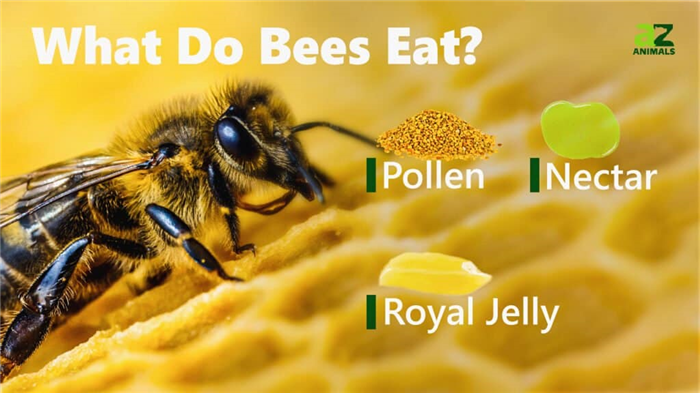
Bees eat pollen, nectar, and royal jelly.
Bees generally feed on two types of flower products: nectar and pollen. Nectar is the sweet sugar-filled liquid produced by plants to attract pollinating animals. The pollen is the powdery substance that contains enough male gametes (the sperm cells) to fertilize another plant. It is also composed of just about all the nutrition a small bee could desire: carbohydrates, proteins, vitamins, and minerals.
Many species have evolved pollen baskets so that, in the process of harvesting food, they will collect some pollen and transfer it to another flower. This is a mutually beneficial relationship that serves the interest of both the bee and the flower. Even if the bee eats some pollen, enough of it will be transferred to fertilize another plant.
Eusocial bees (such as bumblebees, honey bees, and stingless bees) have a unique social structure divided into three basic but distinct classes: drones, workers, and queens. The queen is the one who founds a new colony and produces all of the other bees. When a young female larva is chosen as a new queen, she will be fed a substance called royal jelly, which contains plenty of Vitamin B, fertility stimulants, and other supplements. After consuming the jelly, she will grow to around double the size of an ordinary bee and lay around 2,000 eggs every day during her natural five-year lifecycle.
Compared to the queen and the drones, which mostly serve the purpose of reproduction, the workers alone are specialized for the task of collecting and processing food. When out on foraging trips, they will consume plenty of nectar for themselves and then bring back the remaining food to the rest to the hive. Honey bees (though not bumblebees) can communicate the location of food to other workers with an interesting wiggle dance. It’s believed that each of the dance moves can communicate the direction of the food source concerning the sun, while the length of the dance supposedly communicates the distance.
Another unique behavior of honey bees (and some stingless bees) is the ability to create honey. This involves a complex process in which the worker will ingest nectar, process it, and then store the resulting honey in wax combs for later use in the winter. Most of the honey cultivated for human consumption is produced by a single species: the western honey bee.
Most bees do not generally eat anything besides pollen, nectar, and the occasional fruit. However, there are a few exceptions. The vulture bees of South America feed on dead carrion left over by other animals and then produce a honey-like substance from it.
What Do Bees Eat in the Summer vs. in the Winter?
Bees will generally eat the same things in the winter as in the summer, but the one thing that does change is their feeding strategy. Most species (like carpenter bees and sweat bees) will spend the winter hunkered down in tunnels, holes, or other safe locations, drawing from the stores of food to survive the cold. Honey bees, likewise, will draw down their honey stores to last for the entire winter.
What do Bees Eat the Most?
Nectar is the preferred diet of most adult bees in the summer, spring, and fall, while pollen is generally fed to the larvae, but bees could conceivably eat either food at any point in their lives. They will travel miles from their home every day to find food.
Bees are highly dependent on flowers. They could not survive without them. But whenever flowers aren’t readily available, they will sometimes eat fruit as well.
What do Bees Use to Eat and Drink?
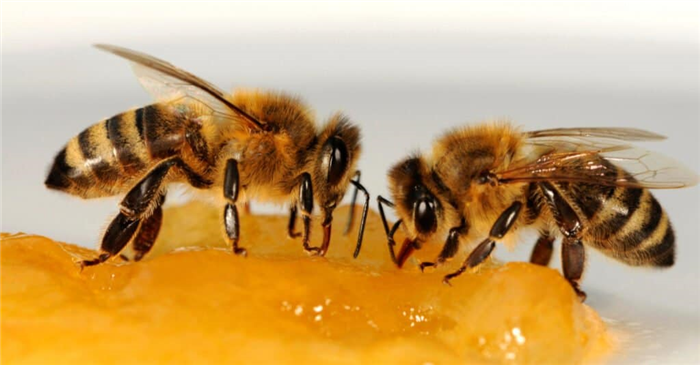
“Honey bees (as well as a few stingless bees) are the only ones that create honey and then consume it.”
The bee is equipped with a very long instrument called a proboscis to reach the center of a flower and collect the nectar inside. The proboscis is roughly analogous to a human tongue, except it resembles a long, thin rod extending from the mouth. The mouth and proboscis are surrounded by strong mandibles, or jaws, to aid in cutting and biting.
Another important body part that aids in their diet (as mentioned previously) is the pollen basket. Located on the bee’s hind legs, it consists of hairs surrounding a curved surface. Upon visiting a flower, the bee will brush all of the pollen toward the basket and then mix in nectar to keep it all stuck together.
Do Bees Eat Fruit?
Yes, bees do have the ability to eat ripened fruit. They’ve been observed to enjoy plums, peaches, grapes, figs, pears, apples, and more.
Honey bees (as well as a few stingless bees) are the only ones that create honey and then consume it.
A Complete List of the Top 5 Foods the Bee Eats
Bees tend to have a very basic diet consisting of only a few foods. Carpenter bees, sweat bees, and most other species rely almost exclusively on nectar and pollen to survive.
Share this post on:
AZ Animals Staff
AZ Animals is a growing team of animals experts, researchers, farmers, conservationists, writers, editors, and — of course — pet owners who have come together to help you better understand the animal kingdom and how we interact.
What Do Bees Eat?
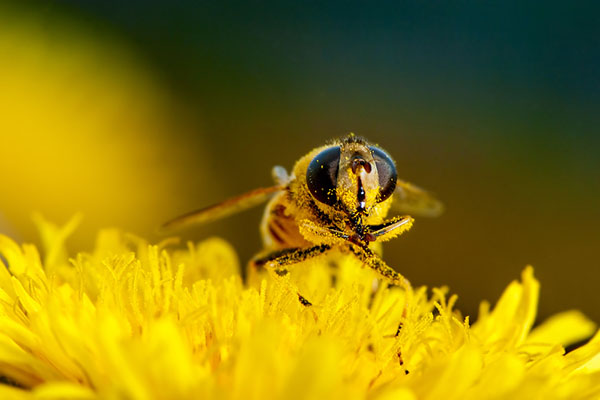
Bees are most commonly seen when they are foraging, which is the process of finding food and water. Bees may fly up to six miles in search of food, and may be quite far from their home when you see them in your yard or neighborhood. And since there are many types of bee, the answer to the question “what do bees eat” has many different answers. Here’s what you need to know:
Q: Why do bees seem to want my food?
A: Honey bees are attracted to sugars, and may be especially attracted to liquid sweets. This is why they may be seen at your picnic or backyard buzzing around your watermelon, soft drinks or frozen treats. While bees are usually not aggressive when foraging for food or water, they can sting when disturbed, which can make them unwelcome guests.
While your sweet treats may be attractive to bees, most bees use pollen and nectar as a food source. Worker bees gather both pollen and nectar from flowers to feed to the larvae and other members of the colony. Nectar is a sweet fluid produced by flowers to attract bees and other animals.
Q: How do bees know which plants to visit?
A: Honey bees rely on their sense of vision to locate flowers. Bees see colors in the spectrum ranging from ultraviolet to orange, but do not see red (red flowers are visited by birds such as hummingbirds). The flower advertises itself to the bees with colorful petals, many of which have shiny patches of ultraviolet that humans can’t see without using special equipment. These ultraviolet patches are called “bee guides” or “nectar guides.” Like airport runway lights, these ultraviolet regions guide the bees to the nectar.
The shape of the flower is also important. Some flowers have flat areas for ease of landing by bees, and others have elaborate modifications to ensure that pollen sticks to any bee that visits.
Q: How do bees eat if some never leave the hive?
A: Worker bees drink the nectar and store it in their crop, an internal storage container. The bees then fly back to the hive and transfer the nectar to other worker bees through a process called trophallaxis. That’s a nice way to say that they regurgitate the nectar to share it with the other bees.
A: The worker bees in the colony mix the nectar with enzymes and deposit it into a cell where it remains exposed to air for a time, allowing some of the water to evaporate. The bees help the process along by fanning the open cells with their wings. The resulting product is what we call honey. The cell containing the honey is later capped with beeswax and kept for future use.
Q: How do bees gather pollen?
A: Pollen is the yellowish or greenish powder-like substance that sometimes comes from flowers. It can be very sticky. Honey bees have lots of little hairs on their body called setae. Pollen sticks to these hairs while the bees are in contact with the flowers. The bee’s movement around the inside of the flower causes it to pick up pollen.
After getting pollen on their body hairs, the bees move it to a special area on their hind legs called pollen baskets. Foraging bees returning to the hive often have bright yellow or greenish balls of pollen hanging from these pollen baskets. Bees without pollen baskets may store pollen in specialized crops.
Q: What do bees eat before they become adults?
A: Honey bees mix the pollen with some nectar to form a high protein food mixture called beebread that is used to feed the immature bees, called larvae.
A: As the worker bees move from flower to flower, they spread pollen to many different plants, including important foods such as vegetables, fruits, nuts, and other plants grown for seed and animal feed, such as clover.
Q: How do Africanized honey bees eat?
A: There is evidence that Africanized honey bees spend more time collecting pollen than do European honey bees, because they need extra protein to produce more bees. One possible reason for the success of Africanized honey bees in displacing European bees is that they out-work them. They get up earlier, work later, and visit more plants than European bees do. When the moon is bright, Africanized honey bees will often continue to forage late into the night.
During hard times when food is not easily accessible, bees will sometimes raid other, weaker honey bee colonies to steal honey. Guard bees at the hive entrance usually try to fight off invaders in stinging duels. Africanized honey bees have a noticeable tendency to raid other colonies, especially during periods of drought or famine.
Q: Do bees need water since nectar is a liquid?
A: In addition to food, honey bees gather water for use in cooling the inside of the nest on hot days. They also use water to dilute the honey when they feed the larvae.
A: While the majority of honey bee larvae eat honey, there are certain larvae that are chosen to become future queens These immature bees will be fed with a substance called royal jelly. Royal jelly is a white secretion produced by young, female worker bees. Workers and drones are only fed royal jelly during the first few days of larval development, while future queen larvae consume royal jelly throughout their development.
Since chosen honey bee queens eat only royal jelly, they grow quickly and become twice the size of an ordinary honey bee.
INFORMATION SHEET 4
Children are most likely to encounter honey bees that are feeding at flowers or foraging . Bees may fly long distances (up to six miles) in search of food and may be quite far from home when they are seen in your yard or neighborhood.
Worker bees gather both pollen and nectar from flowers to feed to the larvae and other members of the colony. Nectar is the sweet fluid produced by flowers to attract bees and other insects, birds and mammals. Worker bees drink the nectar and store it in a pouch-like structure called the crop. They fly back to the hive and regurgitate the nectar to other “house bees.” The house bees mix the nectar with enzymes and deposit it into a cell where it remains exposed to air for a time to allow some of the water to evaporate. The bees help the process along by fanning the open cells with their wings. The cell containing the resulting honey is later capped with beeswax and kept for future use.
Honey bees have lots of little hairs on their body. Even their eyes have hairs. Pollen sticks to the hairs while the bees are visiting the flowers. A furry little bee wiggling around inside the flower picks up a lot of pollen. After getting pollen on their body hairs, the bees move it to a special area on their hind legs called pollen baskets . Foraging bees returning to the hive often have bright yellow or greenish balls of pollen hanging from these pollen baskets.
Pollen is the yellowish or greenish powder-like substance that sometimes comes from flowers. It may be quite sticky. It contains the male contribution to the next generation of plants. Honey bees mix the pollen with some nectar to form a mixture called beebread that is a protein-rich food used to feed the larvae. As the worker bees move from flower to flower, they spread pollen to many different plants, including important foods such as vegetables (squash and cucum bers), fruits (apples, watermelon, plums, sweet cherries, citrus), nuts (almonds), plants grown for seed (sunflower), and animal feed crops such as clover.
There is evidence that Africanized honey bees spend more time collecting pollen than do European honey bees, because they need extra protein to produce more brood. One possible reason for the success of Africanized honey bees in displacing milder-tempered bees is that in every respect, the Africanized honey bees appear to be more efficient and more diligent. They get up earlier, work later, and visit more flowers per foraging flight than do European bees. When the moon is bright, Africanized honey bees will often continue to forage late into the night. This is part of the Africanized honey bee’s tendency to favor expansion and frequent division of the colony, as opposed to the European honey bee’s tendency to build up large, stable colonies full of honey in order to survive the winter.
Honey bees rely on their sense of vision to locate flowers. Bees see colors in the spectrum ranging from ultraviolet to orange, but do not see red, (Red flowers are visited by birds such as hummingbirds.) The flower advertises itself to the bees with colorful petals, many of which have shiny patches of ultraviolet that humans can’t see except with special equipment. These ultraviolet patches are called bee guides or nectar guides. Like airport runway lights, these ultraviolet regions guide the bees to the nectar.
Shape of the flower is also important. Some flowers have flat areas for ease of landing by bees and others have elaborate modifications to ensure pollen sticks to any bee that visits.
During those hard times when there are few foraging opportunities, bees sometimes raid other, weaker colonies looking for honey to steal. The robber bees cannot enter a different hive unnoticed. Guard bees at the hive entrance usually try to fight off invaders in stinging duels. Africanized honey bees have a noticeable tendency to raid other colonies, especially during periods of drought or famine.
Honey bees are attracted to sweets, especially liquid sweets in the form of open cans of soft drinks. This is why they sometimes gather around eating areas at open air events, like fairs and carnivals, and crawl around on straws and can or bottle tops. While bees are generally not very aggressive while foraging for food or water, they can sting when disturbed, which makes them quite unwelcome at such events.
In addition to food, honey bees gather water for use in cooling the inside of the nest on hot days. They also use water to dilute the honey when they feed it to the larvae. Occasionally, honey bees collect the sticky resin and gum of trees and work into a substance called propolis . They used the propolis to plug unwanted openings in the hive so that mice and pests such as wax moths or ants can’t get inside. The bees also spread a thin coating of propolis on the interior of the hive to protect against disease. When working a hive, the beekeeper uses a hive tool to pull apart the frames that may be stuck together with propolis.
What do bees eat?
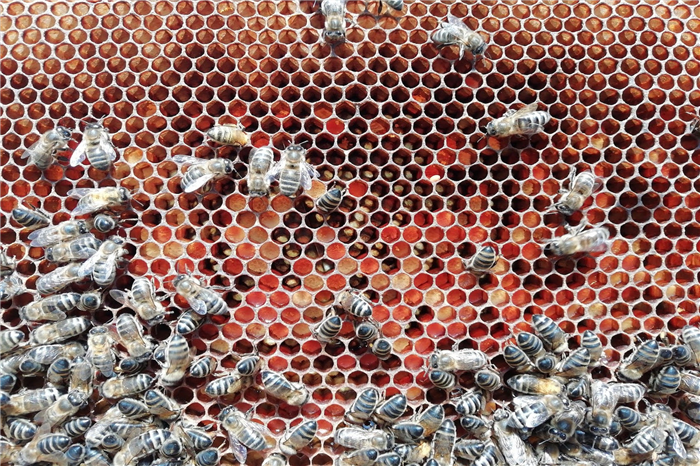
Honey bees need two foods to survive and both of these are provided by plants. The amazing relationship between bees and flowers strikes again. So what are these two vital foods and what exactly do honeybees eat?
They are nectar and pollen. Nectar, eventually to be converted into honey, is a liquid solution of sugar and water. Nectar is a honey bees carbohydrate. Bees convert sugar into energy so nectar is crucial for jobs such as flying, ventilating the hive, building comb etc.
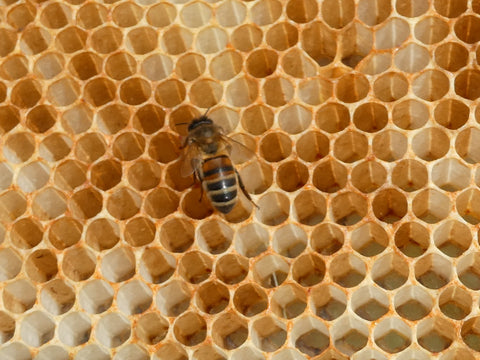
Pollen is the main source of protein for the bees and also provides fats, minerals and vitamins. It is vital for brood production and the development of young bees.
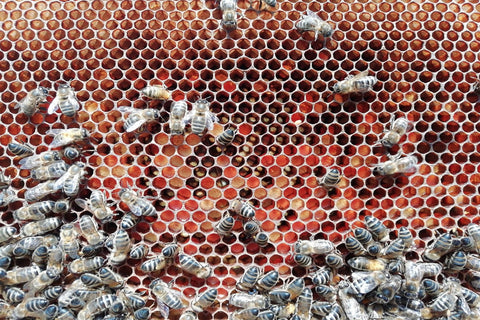
(Pollen in cells)
Not all pollen is created equal and the nutritional value to bees will vary from plant to plant. Protein is made up of amino acids and ten of these have been identified as essential to honey bees. The amino acids present will vary between plants as will the raw protein available.
In terms of diet then, bees are not that different to us. They need variety. The more floral sources available to bees the better. This is why trying to combat the effects of things like climate change, pesticide use and intensive agriculture on biodiversity is essential.
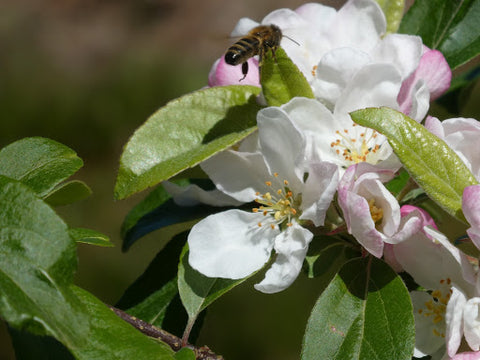
(Honey bee enjoying crab apple)
We’ve talked in many of our blogs about wildflowers and how important these are, both in their own right and as a food source for bees. But there are also trees, shrubs, hedgerows and lawns, all of which provide food and habitat for countless wildlife.
Plantlife, a British conservation charity, are this week asking the question ‘how many bees does your lawn feed?’. They’ve got some brilliant information on how lawns can provide a banquet of food for pollinators. In fact limiting your mowing to once a month can give a huge boost to the flowers growing there. Dr Trevor Dines, a Plantlife botanist says “the sheer quantity of flowers and nectar production on lawns mown once a month can be astonishing”.
What are the bees eating at the moment? If you have any photos of bees on flowers we’d love to see them!
